Key takeaways:
- Documenting recipes involves capturing not just ingredients but also personal stories and techniques that make dishes special.
- Local recipes help preserve cultural heritage, foster a sense of belonging, and promote sustainability through the use of seasonal ingredients.
- Brunch culture encourages creativity in cooking and transforms social gatherings by blending work and leisure.
- Sharing documented recipes with personal anecdotes and engaging with community feedback enriches culinary experiences and connections.
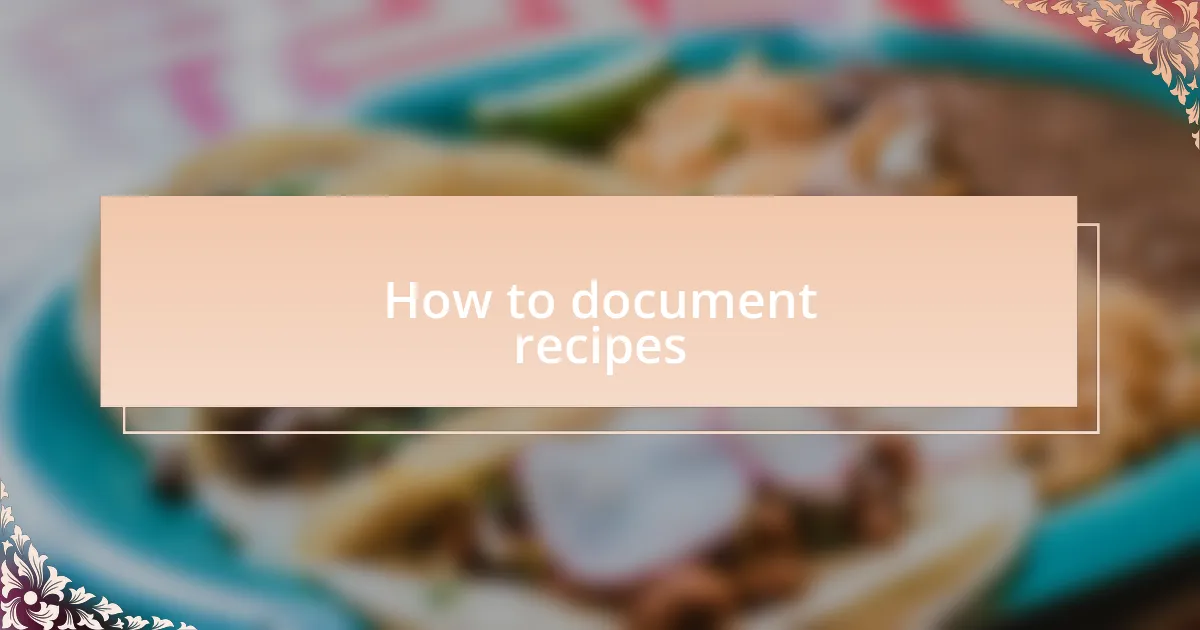
How to document recipes
Documenting recipes is an art that goes beyond just listing ingredients. I remember once, while at my grandmother’s kitchen, she emphasized the importance of noting not just the what, but the how—the little techniques that make a dish special. When I now document a local recipe, I ensure that I capture every nuance, from the texture of the dough to the aroma that fills the air when it’s cooking.
Isn’t it fascinating how a single recipe can tell a story? When I write down a recipe, I often include personal touches, like the first time I tasted the dish or what it means to my family. This not only makes the recipe more relatable, but it also keeps the tradition alive, bridging generations through food.
In my experience, clarity is key. I like to break down the steps into concise, easy-to-follow instructions, often using bullet points. This approach makes it easier for anyone to recreate the magic of that local favorite, ensuring that it lives on and continues to delight others just as it once delighted me.
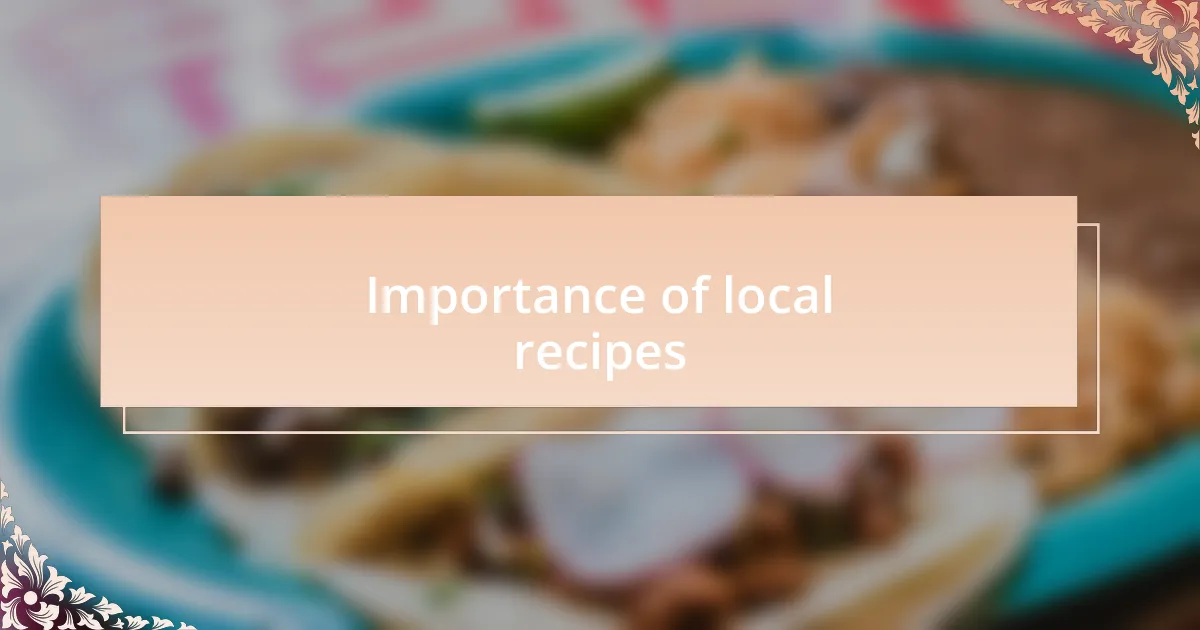
Importance of local recipes
Local recipes are treasures that reflect the unique culture and history of a community. I remember a time when I visited a small town and tasted a family recipe that had been passed down for generations. The flavors transported me back in time, reminding me just how vital these dishes are in preserving our heritage.
Understanding local recipes also fosters a sense of belonging. When I attempt a local dish at home, I feel connected not just to the ingredients but to the people who created it. It’s almost as if I’m sharing a meal with them, even if they’re miles away. Isn’t it incredible how food can create such bonds?
Moreover, local recipes promote sustainability by encouraging the use of seasonal and locally sourced ingredients. I often find that by cooking these dishes, I’m not only supporting local farmers but also enjoying fresher, more flavorful meals. This connection to place not only satisfies the palate but also nurtures the community.
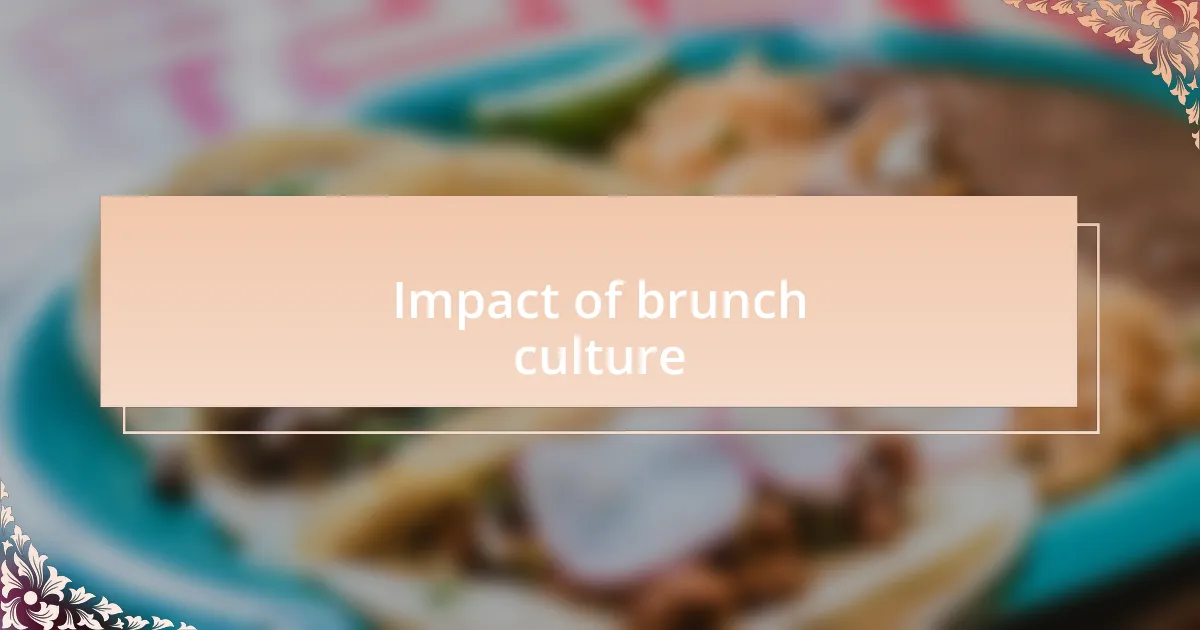
Impact of brunch culture
Brunch culture has significantly transformed how we socialize and enjoy our weekends. I often find myself in a bustling café, surrounded by friends and laughter, savoring a well-crafted meal that feels elevated yet comforting. Isn’t it fascinating how the simple act of enjoying brunch can forge stronger connections between us?
The rise of brunch has also sparked creativity in kitchens everywhere, inspiring chefs and home cooks alike to innovate traditional dishes. I remember experimenting with a savory pancake recipe that I had never tried before, and it turned out to be a crowd-pleaser at my last brunch gathering. Brunch encourages us to push boundaries and play with flavors, making mealtime an exciting adventure.
Moreover, brunch culture reflects our evolving lifestyles. It’s become a space where work, leisure, and dining intertwine. I’ve attended brunch meetings that felt more like celebrations, highlighting how food can foster collaboration and connection. Can you think of a memorable meal that turned a work obligation into a joyful experience? That’s the power of brunch—the ability to make every gathering feel special.
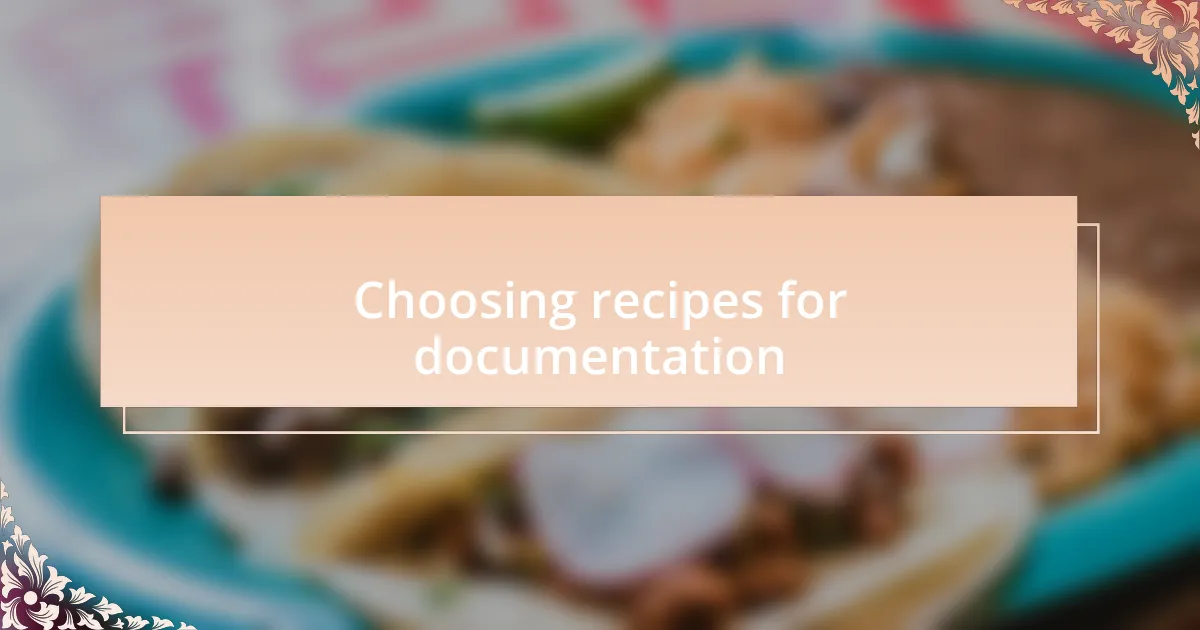
Choosing recipes for documentation
Choosing recipes for documentation requires a thoughtful approach to ensure they resonate with both the restaurant’s identity and the preferences of its patrons. I often find myself flipping through my grandmother’s recipe book, drawn to the warmth of her handwritten notes; it reminds me that a recipe is more than just ingredients—it’s a story waiting to be told. How does your favorite dish reflect the culture surrounding brunch?
When selecting which recipes to document, I prioritize those that highlight local ingredients and seasonal flavors. Last spring, I hosted a brunch featuring a dish made with fresh asparagus and local goat cheese, and the guests were raving about it long after the meal. It wasn’t just about the food; it was about celebrating our community’s bounty. I always ask myself, what flavors evoke a sense of place?
Additionally, I take into account the ease of preparation when choosing recipes for documentation. I remember the excitement of sharing a recipe for a simple yet delicious overnight French toast that anyone could whip up—perfect for a busy brunch morning. Does everyone love a brunch dish that’s both impressive and uncomplicated, or is it just me? Balancing accessibility with creativity is key to appealing to a broad audience.
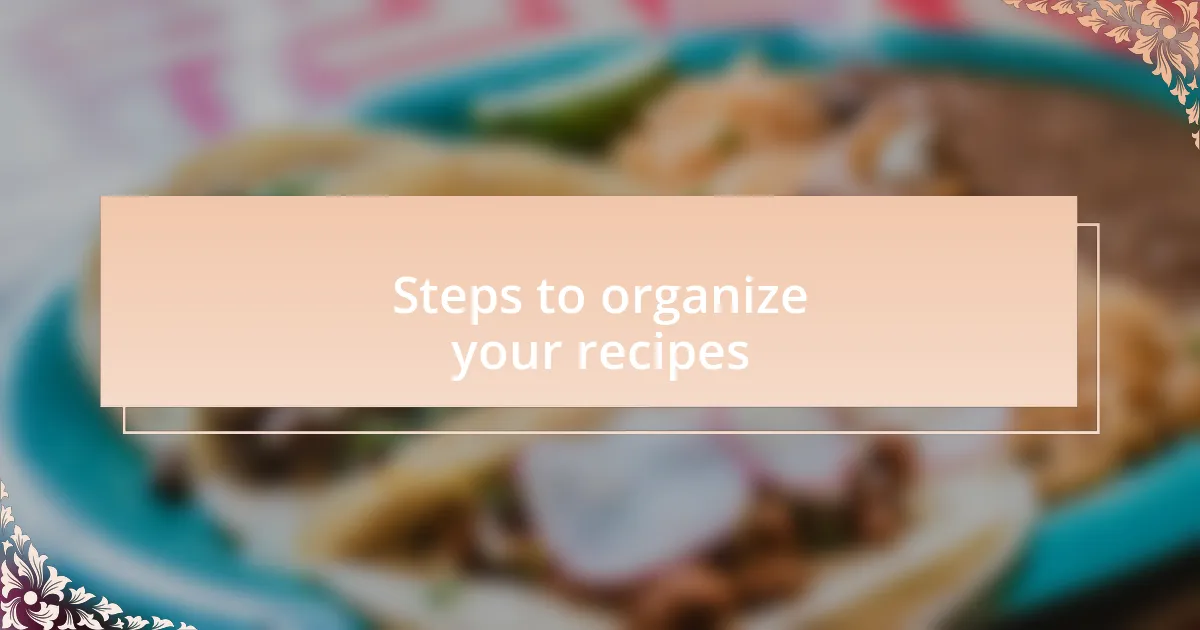
Steps to organize your recipes
When I start organizing recipes, I like to group them by category, such as sweet, savory, and seasonal. This method not only helps in navigating my collection but also sparks inspiration when planning a new brunch menu. Imagine flipping through a section filled with mouthwatering pastries — who wouldn’t be tempted to try something new?
I also consider the origin of each recipe, noting personal anecdotes that connect them to specific moments in my life. For example, I have a pancake recipe that reminds me of lazy Sunday mornings spent with friends, where laughter echoed around the kitchen. Including these stories can transform a simple recipe into an experience, making it more meaningful for anyone who encounters it.
Additionally, I find it helpful to create a digital space for my recipes. I often use a simple spreadsheet to catalog them, making it easy to track updates or modifications. There’s something gratifying about seeing my collection grow—it’s like building a culinary legacy, one dish at a time. Have you ever thought about how your recipes could tell your life story?
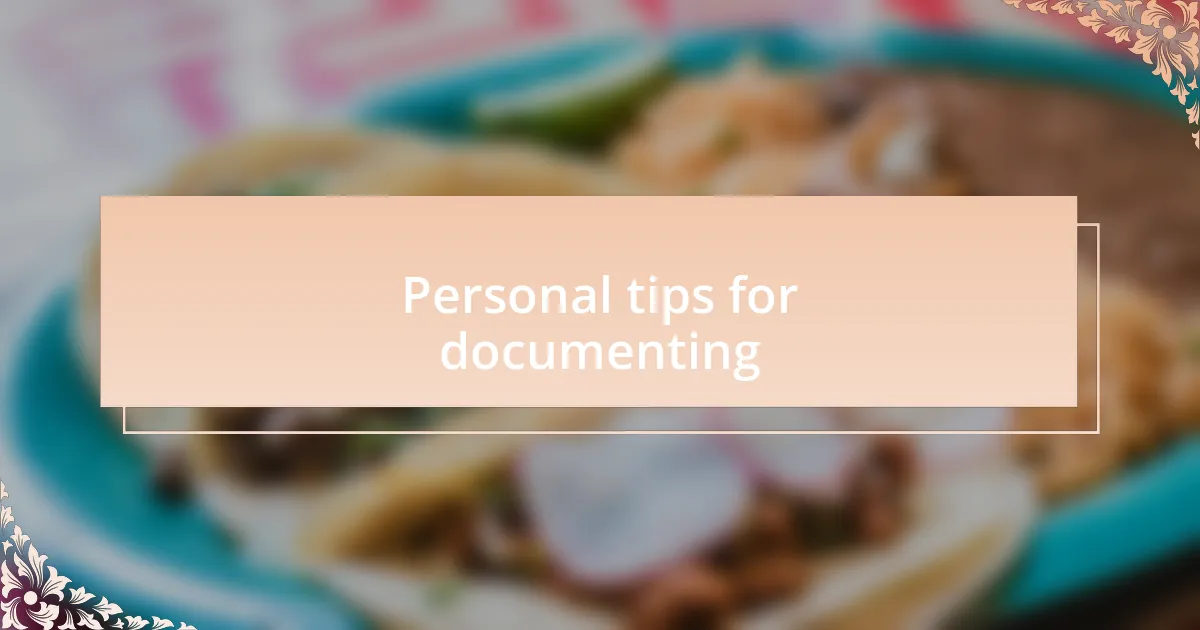
Personal tips for documenting
When it comes to documenting local recipes, I suggest always including your own touch. For instance, I love to jot down what ingredient variations work best for me, like adding a hint of nutmeg to my savory scones. Have you ever experimented with a recipe and discovered a flavor combination that made you smile? Those little tweaks not only customize the dish but also make it truly yours.
A personal tip I often share is to take photographs as you create each recipe. A few years back, I started snapping pictures during my cooking process, capturing everything from the raw ingredients to the final plated dish. It’s amazing how these images help preserve the memory of the moments spent in the kitchen, allowing me to revisit the joy I felt while creating a dish that left an impression on my friends. After all, what is cooking if not a blend of art and emotion?
Don’t forget to record the feedback you receive on your dishes. I always keep notes on what my brunch guests liked or disliked about each recipe. It’s fascinating to see how tastes evolve and how a single dish can elicit strong emotions. Have you considered how this process could shape your future cooking adventures? As you document your culinary journey, you might find that the responses encourage you to explore new flavors and enhance your technique.
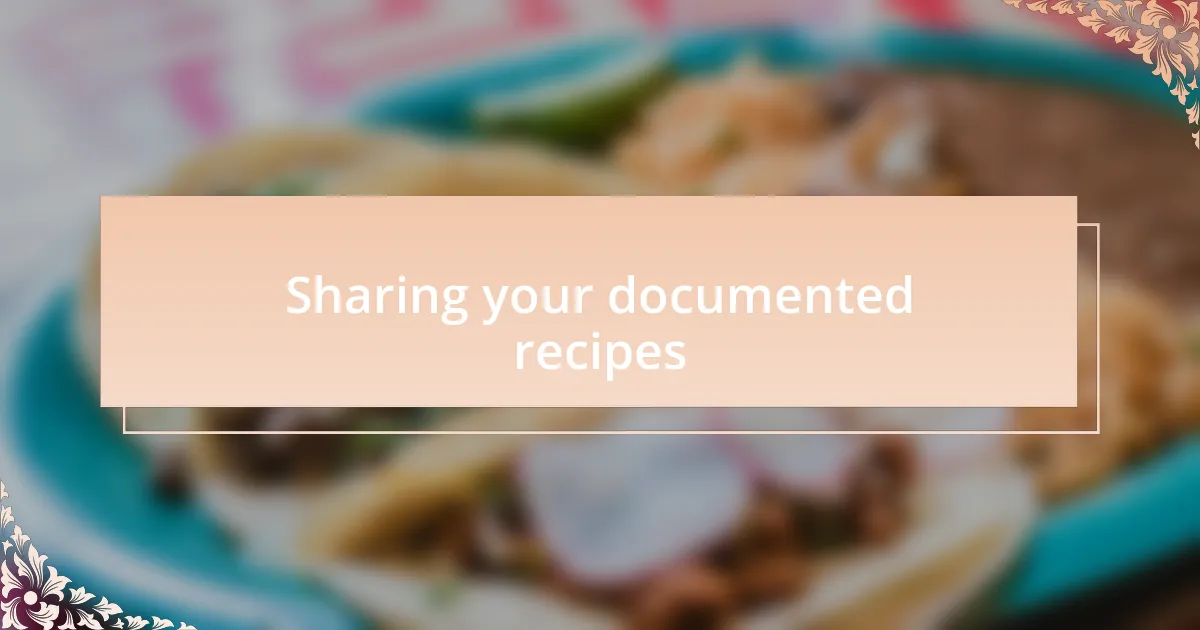
Sharing your documented recipes
When I share my documented recipes, I always make it a point to include notes about the dish’s backstory. For example, there’s a family brunch recipe that was passed down from my grandmother, and I love to describe how it brought us together every Sunday morning. Have you ever considered how adding personal anecdotes can transform a simple recipe into a cherished memory?
Utilizing social media platforms for sharing recipes has been a game-changer for me. I remember posting a recipe for a decadent French toast bake, and the response was overwhelming. Engaging with followers who tried the recipe and shared their own variations turned a solitary cooking activity into a community celebration of flavors. Don’t you think it’s wonderful how food can connect us with others, creating meaningful conversations around the table?
I’ve also found that creating a dedicated section on my website for sharing user-generated content has enriched my recipe collection. A few months back, someone submitted their twist on my famous pancake recipe, and it sparked a delightful exchange of ideas. This collaborative approach not only broadens my culinary horizons but also fosters a sense of belonging among fellow food enthusiasts. How have you seen community involvement shape your cooking experience?